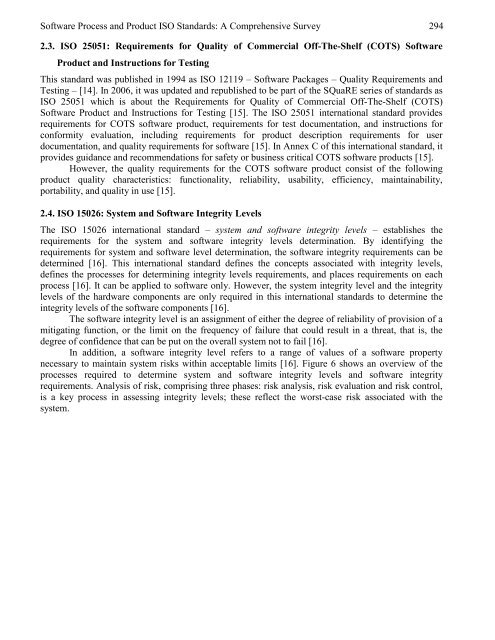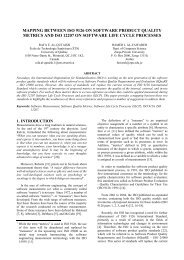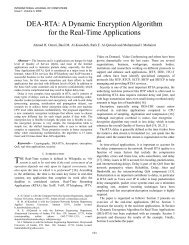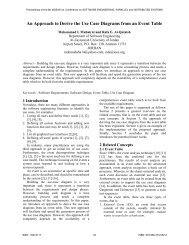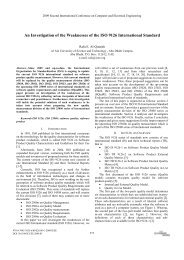Software Process and Product ISO Standards - Dr. Rafa E. AL ...
Software Process and Product ISO Standards - Dr. Rafa E. AL ...
Software Process and Product ISO Standards - Dr. Rafa E. AL ...
- No tags were found...
You also want an ePaper? Increase the reach of your titles
YUMPU automatically turns print PDFs into web optimized ePapers that Google loves.
<strong>Software</strong> <strong>Process</strong> <strong>and</strong> <strong>Product</strong> <strong>ISO</strong> St<strong>and</strong>ards: A Comprehensive Survey 2942.3. <strong>ISO</strong> 25051: Requirements for Quality of Commercial Off-The-Shelf (COTS) <strong>Software</strong><strong>Product</strong> <strong>and</strong> Instructions for TestingThis st<strong>and</strong>ard was published in 1994 as <strong>ISO</strong> 12119 – <strong>Software</strong> Packages – Quality Requirements <strong>and</strong>Testing – [14]. In 2006, it was updated <strong>and</strong> republished to be part of the SQuaRE series of st<strong>and</strong>ards as<strong>ISO</strong> 25051 which is about the Requirements for Quality of Commercial Off-The-Shelf (COTS)<strong>Software</strong> <strong>Product</strong> <strong>and</strong> Instructions for Testing [15]. The <strong>ISO</strong> 25051 international st<strong>and</strong>ard providesrequirements for COTS software product, requirements for test documentation, <strong>and</strong> instructions forconformity evaluation, including requirements for product description requirements for userdocumentation, <strong>and</strong> quality requirements for software [15]. In Annex C of this international st<strong>and</strong>ard, itprovides guidance <strong>and</strong> recommendations for safety or business critical COTS software products [15].However, the quality requirements for the COTS software product consist of the followingproduct quality characteristics: functionality, reliability, usability, efficiency, maintainability,portability, <strong>and</strong> quality in use [15].2.4. <strong>ISO</strong> 15026: System <strong>and</strong> <strong>Software</strong> Integrity LevelsThe <strong>ISO</strong> 15026 international st<strong>and</strong>ard – system <strong>and</strong> software integrity levels – establishes therequirements for the system <strong>and</strong> software integrity levels determination. By identifying therequirements for system <strong>and</strong> software level determination, the software integrity requirements can bedetermined [16]. This international st<strong>and</strong>ard defines the concepts associated with integrity levels,defines the processes for determining integrity levels requirements, <strong>and</strong> places requirements on eachprocess [16]. It can be applied to software only. However, the system integrity level <strong>and</strong> the integritylevels of the hardware components are only required in this international st<strong>and</strong>ards to determine theintegrity levels of the software components [16].The software integrity level is an assignment of either the degree of reliability of provision of amitigating function, or the limit on the frequency of failure that could result in a threat, that is, thedegree of confidence that can be put on the overall system not to fail [16].In addition, a software integrity level refers to a range of values of a software propertynecessary to maintain system risks within acceptable limits [16]. Figure 6 shows an overview of theprocesses required to determine system <strong>and</strong> software integrity levels <strong>and</strong> software integrityrequirements. Analysis of risk, comprising three phases: risk analysis, risk evaluation <strong>and</strong> risk control,is a key process in assessing integrity levels; these reflect the worst-case risk associated with thesystem.


